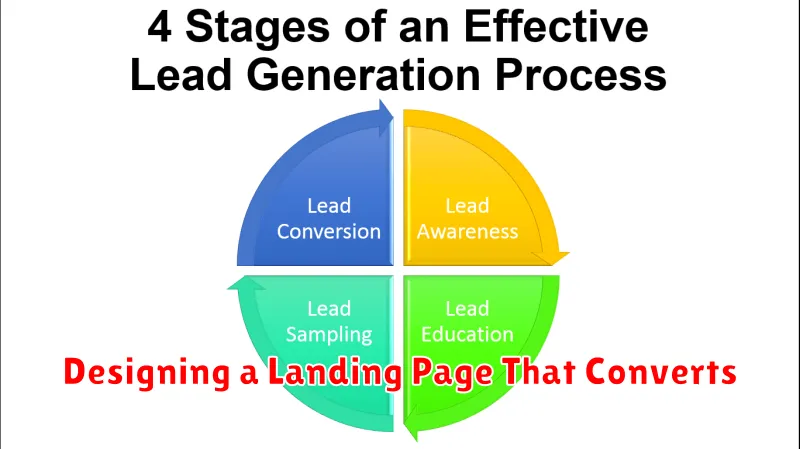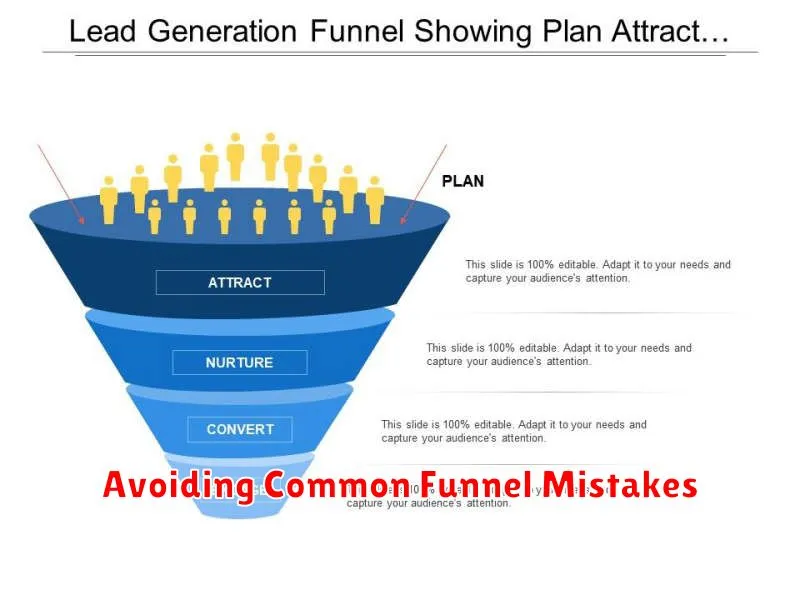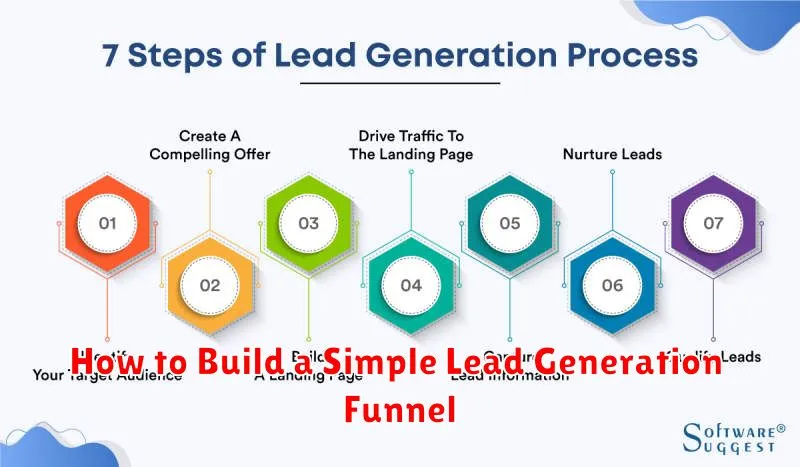Generating leads is the lifeblood of any successful business. Without a consistent influx of potential customers, growth stagnates and revenue streams dry up. This article will provide a comprehensive guide on how to build a simple lead generation funnel, a system designed to attract, engage, and convert prospects into qualified leads. We will explore the essential components of an effective funnel, including lead magnets, landing pages, call-to-actions, and email marketing. Learning how to build a lead generation funnel is a crucial skill for any marketer looking to maximize their return on investment and drive sustainable business growth.
Building a lead generation funnel doesn’t have to be a complex undertaking. By following a few key steps and understanding the fundamentals of lead generation, you can create a streamlined system for capturing valuable leads. This article will walk you through a simple, yet effective, process for building your own lead generation funnel. Whether you are a seasoned marketer or just starting out, this guide will equip you with the knowledge and tools you need to start generating high-quality leads and driving conversions for your business. From creating compelling lead magnets to nurturing leads through email marketing, we will cover the essential elements of a successful lead generation funnel.
What Is a Lead Funnel?
A lead funnel is a systematic process that guides potential customers through the stages of becoming a lead, and ultimately, a paying customer. It visually represents the journey a prospect takes, from initial awareness to final conversion.
The funnel metaphor illustrates how a larger pool of potential customers enters at the top and gradually narrows as prospects progress through the stages. At each stage, some prospects will drop off, leaving only the most qualified and interested individuals towards the bottom.
A typical lead funnel comprises several key stages: awareness, interest, desire, and action. Understanding these stages helps businesses tailor their marketing efforts to effectively nurture leads through the funnel.
Stages: Awareness, Interest, Decision, Action
This framework, often called the AIDA model, represents the customer journey through your lead generation funnel. Awareness is the first stage, where potential customers become aware of your brand or a problem you solve. Marketing efforts at this stage focus on visibility and reaching a broad audience.
Interest is the next stage, where prospects demonstrate curiosity about your offerings. Content like blog posts, videos, and webinars can nurture this interest by providing valuable information.
The Decision stage is when potential customers evaluate your solution against alternatives. Comparison charts, case studies, and free trials can help them make an informed decision.
Finally, the Action stage is where the lead converts into a customer by making a purchase, signing up for a service, or taking another desired action. Clear calls-to-action and streamlined processes are essential at this stage.
Creating a Lead Magnet (Checklist, Ebook, etc)
A lead magnet is something valuable you offer to potential customers in exchange for their contact information. This is crucial for building your email list and nurturing leads. Common lead magnets include checklists, ebooks, templates, webinars, and free trials.
When choosing your lead magnet, consider your target audience’s needs and pain points. What valuable information can you provide that will attract them and establish your expertise? Keep it concise and actionable. A short checklist or template is often more effective than a lengthy ebook that never gets read.
The key is to provide immediate value that solves a problem or helps your audience achieve a specific goal. This builds trust and positions you as a helpful resource, encouraging them to further engage with your brand.
Designing a Landing Page That Converts

A high-converting landing page is crucial for lead generation. Its primary purpose is to capture visitor information in exchange for a valuable offer. This offer could be a lead magnet such as an ebook, webinar registration, or a free trial.
Key elements of a successful landing page include a compelling headline, concise and persuasive copy highlighting the benefits of your offer, a clear call to action, and a visually appealing design. Minimize distractions and keep the form short and easy to complete. Focus on a single conversion goal to avoid confusing visitors.
Testing and optimization are essential. A/B test different versions of your landing page to identify what resonates best with your target audience. Analyze metrics such as conversion rate, bounce rate, and time spent on page to continually improve its performance.
Using Email to Nurture Leads
Email marketing plays a crucial role in nurturing leads captured through your lead generation funnel. Once a visitor converts into a lead by providing their contact information, email becomes the primary channel for building relationships and guiding them towards becoming customers.
A well-structured email sequence can deliver valuable content, address pain points, and build trust. This nurturing process keeps your brand top-of-mind and increases the likelihood of conversion. By providing targeted and relevant information, you can educate leads about your products or services and demonstrate their value.
Tracking Funnel Performance Metrics
Tracking your lead generation funnel’s performance is crucial for optimization and improvement. By monitoring key metrics, you can identify bottlenecks and areas for improvement. This data-driven approach allows you to refine your strategies and maximize your return on investment.
Key metrics to track include:
- Conversion Rates: The percentage of visitors who move from one stage of the funnel to the next.
- Cost Per Lead (CPL): The cost associated with acquiring a single lead.
- Time to Conversion: The time it takes for a lead to progress through the funnel.
Regularly analyzing these metrics helps you understand the effectiveness of your funnel and make informed decisions to enhance its performance.
Segmenting Your Leads Strategically
After generating leads, strategic segmentation is crucial. This involves dividing your leads into specific groups based on shared characteristics. Effective segmentation allows you to tailor your messaging and offers, leading to higher conversion rates.
Common segmentation criteria include demographics (age, location, job title), behavior (website activity, email engagement), and lead source (online form, social media). By understanding these factors, you can personalize your communication, addressing the specific needs and interests of each segment.
For example, leads who downloaded a specific ebook might receive follow-up emails related to that topic. This targeted approach strengthens your connection with leads and moves them further down the sales funnel.
Integrating CRM and Automation Tools
Integrating your CRM and marketing automation tools is a critical step in streamlining your lead generation funnel. This integration allows for a seamless flow of information, from initial contact to conversion. It eliminates manual data entry, reducing errors and saving valuable time.
Key benefits of integration include:
- Automated lead scoring and qualification.
- Personalized email marketing campaigns based on lead behavior.
- Improved lead nurturing through targeted content delivery.
- Enhanced sales team efficiency with readily available lead information.
Choosing the right tools depends on your specific needs and budget. Ensure the chosen tools offer seamless integration capabilities.
Testing and Optimizing Your Funnel
Once your lead generation funnel is established, continuous testing and optimization are crucial. This ensures your funnel remains effective and generates a steady stream of qualified leads. Key Performance Indicators (KPIs) like conversion rates, click-through rates, and cost per lead should be closely monitored.
A/B testing is a powerful technique for optimizing your funnel. This involves creating two slightly different versions (A and B) of an element within your funnel, such as a landing page headline or call-to-action button. By comparing the performance of both versions, you can determine which resonates more effectively with your target audience.
Analyze the data from your tests to identify areas for improvement. This might involve tweaking ad copy, refining landing page design, or simplifying the form submission process. Regularly evaluate and iterate on your funnel based on data insights to maximize its performance.
Avoiding Common Funnel Mistakes

Building a successful lead generation funnel requires diligence and attention to detail. Avoiding common mistakes can significantly improve your conversion rates and overall effectiveness. One frequent error is neglecting to clearly define your target audience. Understanding their needs and pain points is crucial for crafting compelling content and offers.
Another common pitfall is creating a funnel that is too complex or cumbersome. A streamlined and user-friendly experience is essential for keeping potential leads engaged. Finally, failing to analyze and optimize your funnel is a critical mistake. Regularly review your metrics and make adjustments based on the data to maximize your results.

